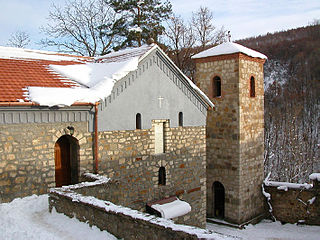
Devič is a Serbian Orthodox abbey in Kosovo. It was built in 1434 and is dedicated to St Joanikije of Devič. Devič was declared Monument of Culture of Exceptional Importance in 1990, and it is protected by the Republic of Serbia.

The Church of the Holy Saviour is a Serbian Orthodox church located in Prizren, Kosovo, built around 1330.

Holy Transfiguration Church is an orthodox church in Gjirokastër, Albania. The church was built in 1784. It is a Cultural Monument of Albania since 1963.

The St. Mary of Blachernae Church is a Byzantine church in Berat, Albania. It is named after the famous Church of St. Mary of Blachernae, near the Palace of Blachernae in Constantinople. It is believed that the church was built on the foundations of a ruined 5th century church that existed at the same place. The church is regarded as one of Berat's most important historical and architectural monuments and is a key tourist attraction for both Berat and Albania.
St. Elijah's Church is a church in Stegopull, Gjirokastër County, Albania. It is a Cultural Monument of Albania.
Mezhan Church is a church in Poliçan, Gjirokastër County, Albania. It is a Cultural Monument of Albania.
St. Nicholas' Monastery Church is a monastery church in Dhivër, Vlorë County, Albania. It is a Cultural Monument of Albania.
Kamenicë Church is a ruined church in Palavli, Delvinë, Albania. It is a Cultural Monument of Albania.
Panagia Monastery Church is a monastery church in Dhërmi, Vlorë County, Albania. It is a Cultural Monument of Albania.
St. Spyridon's Church is a church in Vuno, Vlorë County, Albania. It is a Cultural Monument of Albania.
Hypapante Church is a church in Dhërmi, Vlorë County, Albania. It is a Cultural Monument of Albania.
Mesodhia Church is a church in Vuno, Vlorë County, Albania. It is a Cultural Monument of Albania.
St. Stephen's Church is a ruined church in Dhërmi, Vlorë County, Albania. It is a Cultural Monument of Albania.
St. Andrew's Church is a ruined church in Himarë, Vlorë County, Albania. It is a Cultural Monument of Albania.
St. Elijah's Church is a church in Buhal, Gjirokastër County, Albania. It is a Cultural Monument of Albania.
St. Paraskevi's Church is a church in Selckë, Gjirokastër County, Albania. It became a Cultural Monument of Albania in 1970.
St. Paraskevi's Church is a church in Hllomo, Gjirokastër County, Albania. It is a Cultural Monument of Albania.
St. Mary's Church is a church in Melçan, Vlorë County, Albania. It is a Cultural Monument of Albania.

The Architecture of Albania is a reflection of Albania's historical and cultural heritage. The country's architecture was influenced by its location within the Mediterranean Basin and progressed over the course of history as it was once inhabited by numerous civilisations including the Illyrians, Ancient Greeks, Romans, Byzantines, Venetians, Ottomans as well as modern Austro-Hungarians and Italians. In addition, missionaries, invaders, colonisers and traders brought cultural changes that had a large profound effect on building styles as well as techniques.






